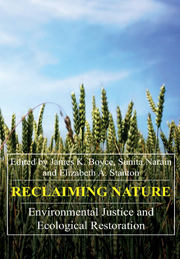Book contents
- Frontmatter
- Contents
- List of Figures and Tables
- Acknowledgements
- Introduction
- Part I ADDING VALUE
- Part II DEMOCRATIZING ACCESS
- Part III CAPTURING BENEFITS
- 9 Compensation for Environmental Services and Rural Communities: Lessons from the Americas
- 10 Certification Systems as Tools for Natural Asset Building
- 11 Wastes as Assets: Limits and Potentials
- 12 Community Rights and Wildlife Stewardship: Zimbabwe's CAMPFIRE Programme
- Part IV DEFENDING THE COMMONS
- About the Contributors
- Index
11 - Wastes as Assets: Limits and Potentials
from Part III - CAPTURING BENEFITS
Published online by Cambridge University Press: 05 March 2012
- Frontmatter
- Contents
- List of Figures and Tables
- Acknowledgements
- Introduction
- Part I ADDING VALUE
- Part II DEMOCRATIZING ACCESS
- Part III CAPTURING BENEFITS
- 9 Compensation for Environmental Services and Rural Communities: Lessons from the Americas
- 10 Certification Systems as Tools for Natural Asset Building
- 11 Wastes as Assets: Limits and Potentials
- 12 Community Rights and Wildlife Stewardship: Zimbabwe's CAMPFIRE Programme
- Part IV DEFENDING THE COMMONS
- About the Contributors
- Index
Summary
Introduction
In the 1980s, a photograph of scavengers, some of them children, picking through garbage at Manila's ‘Smoky Mountain’ dumpsite came to represent poverty in the Philippines. In 1995, the government closed the over-filled dumpsite, announcing plans to convert it into a low-cost housing development and an industrial zone. But the 1997 Asian financial crisis caught up with the project, and the promise of a better life for the scavengers remained unfulfilled.
The closure of Smokey Mountain threatened to deprive scavengers and their families of their only source of livelihood. A year before the closure, they were already following the re-routed garbage trucks more than 20 kilometres away to what is now the largest dumpsite in the country — Payatas in Quezon City (Rivera 1994, 53). If the garbage mountain represented poverty, why did the poor follow it? The reason is that to the 4,000–8,000 families who depend on the Payatas dumpsite, garbage is not a symbol of poverty: it is an asset (Tuason 2002, 1).
This chapter describes how poor families living in the Payatas dumpsite earn an income and create jobs for their neighbours by recovering and recycling wastes. A few, who have become traders and small producers, have managed to penetrate the country's biggest supermarkets and even the export market with their recycled products. The scavengers of Payatas have shown that waste recovery and recycling can simultaneously help to reduce poverty and protect the environment.
- Type
- Chapter
- Information
- Reclaiming NatureEnvironmental Justice and Ecological Restoration, pp. 289 - 312Publisher: Anthem PressPrint publication year: 2007



